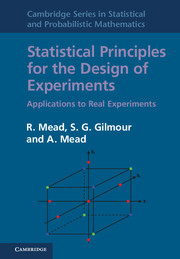Book contents
- Frontmatter
- Contents
- Preface
- Part I Overture
- 1 Introduction
- 2 Elementary ideas of blocking: the randomised complete block design
- 3 Elementary ideas of treatment structure
- 4 General principles of linear models for the analysis of experimental data
- Part II First subject
- Part III Second subject
- Part IV Coda
- References
- Index
1 - Introduction
from Part I - Overture
Published online by Cambridge University Press: 05 November 2012
- Frontmatter
- Contents
- Preface
- Part I Overture
- 1 Introduction
- 2 Elementary ideas of blocking: the randomised complete block design
- 3 Elementary ideas of treatment structure
- 4 General principles of linear models for the analysis of experimental data
- Part II First subject
- Part III Second subject
- Part IV Coda
- References
- Index
Summary
Why a statistical theory of design?
The need to develop statistical theory for designing experiments stems, like the need for statistical analysis of numerical information, from the inherent variability of experimental results. In the physical sciences, this variability is frequently small and, when thinking of experiments at school in physics and chemistry, it is usual to think of ‘the correct result’ from an experiment. However, practical experience of such experiments makes it obvious that the results are, to a limited extent, variable, this variation arising as much from the complexities of the measurement procedure as from the inherent variability of experimental material. As the complexity of the experiment increases, and the differences of interest become relatively smaller, then the precision of the experiment becomes more important. An important area of experimentation within the physical sciences, where precision of results and hence the statistical design of experiments is important, is the optimisation and control of industrial chemical processes.
Whereas the physical sciences are thought of as exact, it is quite obvious that biological sciences are not. Most experiments on plants or animals use many plants or animals because it is clear that the variation between plants, or between animals, is very large. It is impossible, for example, to predict quantitatively the exact characteristics of one plant from the corresponding characteristics of another plant of the same species, age and origin.
Thus, no medical research worker would make confident claims for the efficacy of a new drug merely because a single patient responded well to the drug. In the field of market research, no newspaper would publish an opinion poll based on interviews with only two people, but would require a sample of at least 500, together with information about the method of selection of the sample.
Information
- Type
- Chapter
- Information
- Statistical Principles for the Design of ExperimentsApplications to Real Experiments, pp. 3 - 8Publisher: Cambridge University PressPrint publication year: 2012
